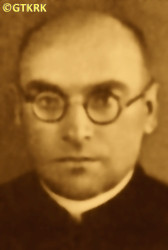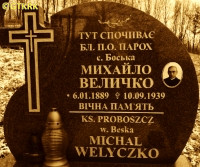Roman Catholic
St Sigismund parish
05-507 Słomczyn
85 Wiślana Str.
Konstancin deanery
Warsaw archdiocese, Poland
full list:
displayClick to display full list

searchClick to search full list by categories
wyświetlKliknij by wyświetlić pełną listę po polsku

szukajKliknij by przeszukać listę wg kategorii po polsku

Martyrology of the clergy — Poland
XX century (1914 – 1989)
personal data
surname
WEŁYCZKO
surname
versions/aliases
WIELICZKO
forename(s)
Michael (pl. Michał)
function
eparchial priest
creed
Ukrainian Greek Catholic GCmore on
en.wikipedia.org
[access: 2013.05.19]
diocese / province
Apostolic GC Exarchate of Lemkowszczyznamore on
en.wikipedia.org
[access: 2024.03.02]
Przemyśl GC eparchymore on
pl.wikipedia.org
[access: 2013.05.19]
nationality
Ukrainian
date and place
of death
10.09.1939

Beskotoday: Besko gm., Sanok pov., Subcarpathia voiv., Poland
more on
en.wikipedia.org
[access: 2021.12.18]
alt. dates and places
of death
09.09.1939, 11.09.1939
details of death
After German invasion of Poland on 01.09.1939 (Russians invaded Poland 17 days later) and start of the World War II murdered when walking back from the church to his rectory, in retaliation for a shot fired by a Pole towards advancing German military unit.
Germans murdered together c. 22 village inhabitants and set c. 40 farms and houses on fire — German soldiers run through the village on motorcycles and tossed grenades into local houses.
cause of death
mass murder
perpetrators
Germans
sites and events
GeneralgouvernementClick to display the description, Ribbentrop‐MolotovClick to display the description, Pius XI's encyclicalsClick to display the description
date and place
of birth
07.01.1889

Skład Solnytoday: part of Barycz village, Stubno gm., Przemyśl pov., Subcarpathia voiv., Poland
more on
en.wikipedia.org
[access: 2021.12.18]
parents
WEŁYCZKO Andrew
🞲 ?, ? — 🕆 ?, ?

MALIK Anne
🞲 ?, ? — 🕆 ?, ?
presbyter (holy orders)
ordination
18.11.1917

Przemyśltoday: Przemyśl city pov., Subcarpathia voiv., Poland
more on
en.wikipedia.org
[access: 2021.04.01]
St Therese GC cathedral churchmore on
en.wikipedia.org
[access: 2025.03.14]
positions held
1939
dean — Rymanówtoday: Rymanów gm., Krosno pov., Subcarpathia voiv., Poland
more on
en.wikipedia.org
[access: 2021.10.09] GC deanery
1934 – c. 1936
dean — Rymanówtoday: Rymanów gm., Krosno pov., Subcarpathia voiv., Poland
more on
en.wikipedia.org
[access: 2021.10.09] GC deanery
1935 – 1939
parish priest — Beskotoday: Besko gm., Sanok pov., Subcarpathia voiv., Poland
more on
en.wikipedia.org
[access: 2021.12.18] ⋄ Nativity of the Blessed Virgin Mary GC parish ⋄ Rymanówtoday: Rymanów gm., Krosno pov., Subcarpathia voiv., Poland
more on
en.wikipedia.org
[access: 2021.10.09] GC deanery
1928 – 1935
parish priest — Wola Niżnatoday: Jaśliska gm., Krosno pov., Subcarpathia voiv., Poland
more on
en.wikipedia.org
[access: 2021.12.18] ⋄ Translation of the relics of St Nicholas the Wonderworker GC parish ⋄ Rymanówtoday: Rymanów gm., Krosno pov., Subcarpathia voiv., Poland
more on
en.wikipedia.org
[access: 2021.10.09] GC deanery
1926 – 1928
administrator — Wola Niżnatoday: Jaśliska gm., Krosno pov., Subcarpathia voiv., Poland
more on
en.wikipedia.org
[access: 2021.12.18] ⋄ Translation of the relics of St Nicholas the Wonderworker GC parish ⋄ Rymanówtoday: Rymanów gm., Krosno pov., Subcarpathia voiv., Poland
more on
en.wikipedia.org
[access: 2021.10.09] GC deanery
1925 – 1926
administrator — Polanytoday: Krempna gm., Jasło pov., Subcarpathia voiv., Poland
more on
en.wikipedia.org
[access: 2022.01.22] ⋄ St John Chrysostom GC parish ⋄ Duklatoday: Dukla gm., Krosno pov., Subcarpathia voiv., Poland
more on
en.wikipedia.org
[access: 2021.10.09] GC deanery
1917 – 1924
vicar — Wiązownicatoday: Wiązownica gm., Jarosław pov., Subcarpathia voiv., Poland
more on
en.wikipedia.org
[access: 2021.10.09] ⋄ Transfiguration of the Lord GC parish ⋄ Jarosławtoday: Jarosław gm., Jarosław pov., Subcarpathia voiv., Poland
more on
en.wikipedia.org
[access: 2021.04.01] GC deanery
1917
student — Przemyśltoday: Przemyśl city pov., Subcarpathia voiv., Poland
more on
en.wikipedia.org
[access: 2021.04.01] ⋄ philosophy and theology, Greek Catholic Theological Seminary
1912 – 1914
student — Lvivtoday: Lviv urban hrom., Lviv rai., Lviv obl., Ukraine
more on
en.wikipedia.org
[access: 2022.01.16] ⋄ philosophy and theology, Greek Catholic Theological Seminary
married — three children
others related
in death
ANDREJCZUKClick to display biography Peter, DIAKClick to display biography Basil, DOBRZAŃSKIClick to display biography Nicholas, HAJDIUKClick to display biography Michael, HAJDIUKClick to display biography Michael, HOŁOWACZClick to display biography Nicholas, HORECZKOClick to display biography Michael, LESZCZUKClick to display biography Joseph, KOSTYSZYNClick to display biography Vladimir, LISKIEWICZClick to display biography Nicholas, ŁEMCIOClick to display biography Vladimir, NIMYŁOWICZClick to display biography Demetrius, SZAŁASZClick to display biography Steven, SZCZERBAClick to display biography Yaroslav, SZEWCZUKClick to display biography Basil, SZUMIŁOClick to display biography Rostislav, WENHRYNOWICZClick to display biography Orestes, WENHRYNOWICZClick to display biography Stephen Emilian, WENHRYNOWICZClick to display biography Vladimir, ZAWOROTIUKClick to display biography Michael, DLABOGAClick to display biography Paul, FEDYSOWClick to display biography Vladimir, KOSTEKClick to display biography Miroslav
sites and events
descriptions
Generalgouvernement: After the Polish defeat in the 09.1939 campaign, which was the result of the Ribbentrop‐Molotov Pact and constituted the first stage of World War II, and the beginning of German occupation in part of Poland (in the other, eastern part of Poland, the Russian occupation began), the Germans divided the occupied Polish territory into five main regions. In two of them new German provinces were created, two other were incorporated into other provinces. However, the fifth part was treated separately, and in a political sense it was supposed to recreate the German idea from 1915 (during World War I, after the defeat of the Russians in the Battle of Gorlice in 05.1915) of creating a Polish enclave within Germany. Illegal in the sense of international law, i.e. Hague Convention, and public law, managed by the Germans according to separate laws — especially established for the Polish Germ. Untermenschen (Eng. subhumans) — till the Russian offensive in 1945 it constituted part of the Germ. Großdeutschland (Eng. Greater Germany). Till 31.07.1940 formally called Germ. Generalgouvernement für die besetzten polnischen Gebiete (Eng. General Government for the occupied Polish lands) — later simply Germ. Generalgouvernement (Eng. General Governorate), as in the years 1915‐1918. From 07.1941, i.e. after the German attack on 22.06.1941 against the erstwhile ally, the Russians, it also included the Galicia district, i.e. the Polish pre‐war south‐eastern voivodeships. A special criminal law was enacted and applied to Poles and Jews, allowing for the arbitrary administration of the death penalty regardless of the age of the „perpetrator”, and sanctioning the use of collective responsibility. After the end of the military conflict of the World War UU, the government of the Germ. Generalgouvernement was recognized as a criminal organization, and its leader, governor Hans Frank, guilty of war crimes and crimes against humanity and executed. (more on: en.wikipedia.orgClick to attempt to display webpage
[access: 2024.12.13])
Ribbentrop‐Molotov: Genocidal Russian‐German alliance pact between Russian leader Joseph Stalin and German leader Adolf Hitler signed on 23.08.1939 in Moscow by respective foreign ministers, Mr. Vyacheslav Molotov for Russia and Joachim von Ribbentrop for Germany. The pact sanctioned and was the direct cause of joint Russian and German invasion of Poland and the outbreak of the World War II in 09.1939. In a political sense, the pact was an attempt to restore the status quo ante before 1914, with one exception, namely the „commercial” exchange of the so‐called „Kingdom of Poland”, which in 1914 was part of the Russian Empire, fore Eastern Galicia (today's western Ukraine), in 1914 belonging to the Austro‐Hungarian Empire. Galicia, including Lviv, was to be taken over by the Russians, the „Kingdom of Poland” — under the name of the General Governorate — Germany. The resultant „war was one of the greatest calamities and dramas of humanity in history, for two atheistic and anti‐Christian ideologies — national and international socialism — rejected God and His fifth Decalogue commandment: Thou shall not kill!” (Abp Stanislav Gądecki, 01.09.2019). The decisions taken — backed up by the betrayal of the formal allies of Poland, France and Germany, which on 12.09.1939, at a joint conference in Abbeville, decided not to provide aid to attacked Poland and not to take military action against Germany (a clear breach of treaty obligations with Poland) — were on 28.09.1939 slightly altered and made more precise when a treaty on „German‐Russian boundaries and friendship” was agreed by the same murderous signatories. One of its findings was establishment of spheres of influence in Central and Eastern Europe and in consequence IV partition of Poland. In one of its secret annexes agreed, that: „the Signatories will not tolerate on its respective territories any Polish propaganda that affects the territory of the other Side. On their respective territories they will suppress all such propaganda and inform each other of the measures taken to accomplish it”. The agreements resulted in a series of meeting between two genocidal organization representing both sides — German Gestapo and Russian NKVD when coordination of efforts to exterminate Polish intelligentsia and Polish leading classes (in Germany called «Intelligenzaktion», in Russia took the form of Katyń massacres) where discussed. Resulted in deaths of hundreds of thousands of Polish intelligentsia, including thousands of priests presented here, and tens of millions of ordinary people,. The results of this Russian‐German pact lasted till 1989 and are still in evidence even today. (more on: en.wikipedia.orgClick to attempt to display webpage
[access: 2015.09.30])
Pius XI's encyclicals: Facing the creation of two totalitarian systems in Europe, which seemed to compete with each other, though there were more similarities than contradictions between them, Pope Pius XI issued in 03.1937 (within 5 days) two encyclicals. In the „Mit brennender Sorge” (Eng. „With Burning Concern”) published on 14.03.1938, condemned the national socialism prevailing in Germany. The Pope wrote: „Whoever, following the old Germanic‐pre‐Christian beliefs, puts various impersonal fate in the place of a personal God, denies the wisdom of God and Providence […], whoever exalts earthly values: race or nation, or state, or state system, representatives of state power or other fundamental values of human society, […] and makes them the highest standard of all values, including religious ones, and idolizes them, this one […] is far from true faith in God and from a worldview corresponding to such faith”. On 19.03.1937, published „Divini Redemptoris” (Eng. „Divine Redeemer”), in which criticized Russian communism, dialectical materialism and the class struggle theory. The Pope wrote: „Communism deprives man of freedom, and therefore the spiritual basis of all life norms. It deprives the human person of all his dignity and any moral support with which he could resist the onslaught of blind passions […] This is the new gospel that Bolshevik and godless communism preaches as a message of salvation and redemption of humanity”… Pius XI demanded that the established human law be subjected to the natural law of God , recommended the implementation of the ideal of a Christian state and society, and called on Catholics to resist. Two years later, National Socialist Germany and Communist Russia came together and started World War II. (more on: www.vatican.vaClick to attempt to display webpage
[access: 2023.05.28], www.vatican.vaClick to attempt to display webpage
[access: 2023.05.28])
sources
personal:
besko.plClick to attempt to display webpage
[access: 2015.03.01], www.nasze-slowo.plClick to attempt to display webpage
[access: 2019.12.01], www.vox-populi.com.uaClick to attempt to display webpage
[access: 2015.03.01], www.straty.plClick to attempt to display webpage
[access: 2015.04.18]
bibliographical:
„Clergy of Przemyśl Eparchy and Apostolic Exarchate of Lemkivshchyna”, Bogdan Prach, Ukrainian Catholic University Publishing House, Lviv 2015
original images:
historicgraves.comClick to attempt to display webpage
[access: 2019.12.01], historicgraves.comClick to attempt to display webpage
[access: 2019.12.01]
LETTER to CUSTODIAN/ADMINISTRATOR
If you have an Email client on your communicator/computer — such as Mozilla Thunderbird, Windows Mail or Microsoft Outlook, described at WikipediaPatrz:
en.wikipedia.org, among others — try the link below, please:
LETTER to CUSTODIAN/ADMINISTRATORClick and try to call your own Email client
If however you do not run such a client or the above link is not active please send an email to the Custodian/Administrator using your account — in your customary email/correspondence engine — at the following address:

giving the following as the subject:
MARTYROLOGY: WEŁYCZKO Michael
To return to the biography press below:
 Click to return to biography
Click to return to biography









